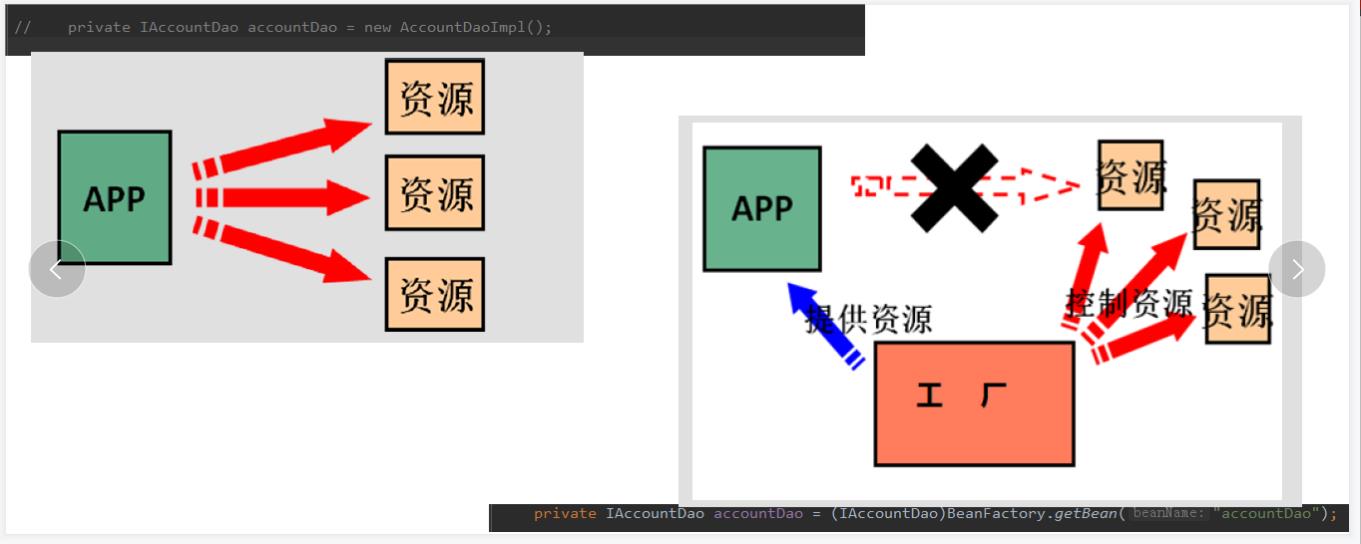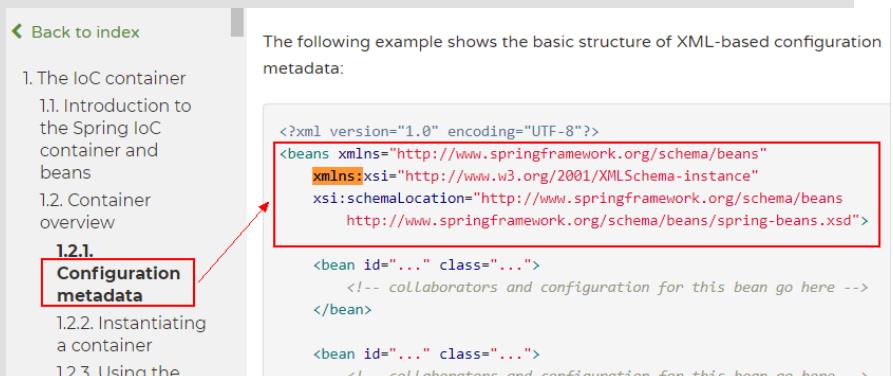Spring
Posted m0_56426304
tags:
篇首语:本文由小常识网(cha138.com)小编为大家整理,主要介绍了Spring相关的知识,希望对你有一定的参考价值。
目录
spring 的优势
程序的耦合及解耦
bean.propertiesaccountService=com.itheima.service.impl.AccountServiceImpl accountDao=com.itheima.dao.impl.AccountDaoImplBeanfactory
/** * 一个创建Bean对象的工厂 * * Bean:在计算机英语中,有可重用组件的含义。 * JavaBean:用java语言编写的可重用组件。 * javabean > 实体类 * * 它就是创建我们的service和dao对象的。 * * 第一个:需要一个配置文件来配置我们的service和dao * 配置的内容:唯一标识=全限定类名(key=value) * 第二个:通过读取配置文件中配置的内容,反射创建对象 * * 我的配置文件可以是xml也可以是properties */ public class BeanFactory { //定义一个Properties对象 private static Properties props; //定义一个Map,用于存放我们要创建的对象。我们把它称之为容器 private static Map<String,Object> beans; //使用静态代码块为Properties对象赋值 static { try { //实例化对象 props = new Properties(); //获取properties文件的流对象 InputStream in = BeanFactory.class.getClassLoader().getResourceAsStream("bean.properties"); props.load(in); //实例化容器 beans = new HashMap<String,Object>(); //取出配置文件中所有的Key Enumeration keys = props.keys(); //遍历枚举 while (keys.hasMoreElements()){ //取出每个Key String key = keys.nextElement().toString(); //根据key获取value String beanPath = props.getProperty(key); //反射创建对象 Object value = Class.forName(beanPath).newInstance(); //把key和value存入容器中 beans.put(key,value); } }catch(Exception e){ throw new ExceptionInInitializerError("初始化properties失败!"); } } /** * 根据bean的名称获取对象 * @param beanName * @return */ public static Object getBean(String beanName){ return beans.get(beanName); } /** * 根据Bean的名称获取bean对象 * @param beanName * @return public static Object getBean(String beanName){ Object bean = null; try { String beanPath = props.getProperty(beanName); // System.out.println(beanPath); bean = Class.forName(beanPath).newInstance();//每次都会调用默认构造函数创建对象 }catch (Exception e){ e.printStackTrace(); } return bean; }*/ }Client
/** * 模拟一个表现层,用于调用业务层 */ public class Client { public static void main(String[] args) { //IAccountService as = new AccountServiceImpl(); for(int i=0;i<5;i++) { IAccountService as = (IAccountService) BeanFactory.getBean("accountService"); System.out.println(as); as.saveAccount(); } } }IAccountService(I开头的为接口)
/** * 账户业务层的接口 */ public interface IAccountService { /** * 模拟保存账户 */ void saveAccount(); }AccountServiceImp
/** * 账户的业务层实现类 */ public class AccountServiceImpl implements IAccountService { // private IAccountDao accountDao = new AccountDaoImpl(); private IAccountDao accountDao = (IAccountDao)BeanFactory.getBean("accountDao"); // private int i = 1; public void saveAccount(){ int i = 1; accountDao.saveAccount(); System.out.println(i); i++; } }
IOC概念和spring中的IOC
ioc的概念图

spring中的ioc
前期准备
官网: http://spring.io/下载地址:http://repo.springsource.org/libs-release-local/org/springframework/spring解压 :(Spring 目录结构 :)* docs :API 和开发规范* libs :jar 包和源码* schema :约束 特别说明:spring5 版本是用 jdk8 编写的,所以要求我们的 jdk 版本是 8 及以上同时 tomcat 的版本要求 8.5 及以上
特别说明:spring5 版本是用 jdk8 编写的,所以要求我们的 jdk 版本是 8 及以上同时 tomcat 的版本要求 8.5 及以上
/**
* 账户的业务层接口
* @author 黑马程序员
* @Company http://www.ithiema.com
* @Version 1.0
*/
public interface IAccountService {
/**
* 保存账户(此处只是模拟,并不是真的要保存)
*/
void saveAccount();
}
/**
* 账户的业务层实现类
* @author 黑马程序员
* @Company http://www.ithiema.com
* @Version 1.0
*/
public class AccountServiceImpl implements IAccountService {
private IAccountDao accountDao = new AccountDaoImpl();//此处的依赖关系有待解决
@Override
public void saveAccount() {
accountDao.saveAccount();
}
}/**
* 账户的持久层接口
* @author 黑马程序员
* @Company http://www.ithiema.com
* @Version 1.0
*/
public interface IAccountDao {
/**
* 保存账户
*/
void saveAccount();
}
/**
* 账户的持久层实现类
* @author 黑马程序员
* @Company http://www.ithiema.com
* @Version 1.0
*/
public class AccountDaoImpl implements IAccountDao {
@Override
public void saveAccount() {
System.out.println("保存了账户");
}
}基于 XML 的配置

/spring-framework-5.0.2.RELEASE/docs/spring-framework-reference/html5/core.html

<?xml version="1.0" encoding="UTF-8"?>
<beans xmlns="http://www.springframework.org/schema/beans"
xmlns:xsi="http://www.w3.org/2001/XMLSchema-instance"
xsi:schemaLocation="http://www.springframework.org/schema/beans
http://www.springframework.org/schema/beans/spring-beans.xsd">
</beans><!-- bean 标签:用于配置让 spring 创建对象,并且存入 ioc 容器之中
id 属性:对象的唯一标识。
class 属性:指定要创建对象的全限定类名
-->
<!-- 配置 service -->
<bean id="accountService" class="com.itheima.service.impl.AccountServiceImpl">
</bean>
<!-- 配置 dao -->
<bean id="accountDao" class="com.itheima.dao.impl.AccountDaoImpl"></bean>/**
* 模拟一个表现层
* @author 黑马程序员
* @Company http://www.ithiema.com
* @Version 1.0
*/
public class Client {
/** * 使用 main 方法获取容器测试执行
*/
public static void main(String[] args) {
//1.使用 ApplicationContext 接口,就是在获取 spring 容器
ApplicationContext ac = new ClassPathXmlApplicationContext("bean.xml");
//2.根据 bean 的 id 获取对象
IAccountService aService = (IAccountService) ac.getBean("accountService");
System.out.println(aService);
IAccountDao aDao = (IAccountDao) ac.getBean("accountDao");
System.out.println(aDao);
}
}Spring 基于 XML 的 IOC 细节

BeanFactory 才是 Spring 容器中的顶层接口ApplicationContext 是它的子接口 (使用多一点)BeanFactory 和 ApplicationContext 的区别: 创建对象的时间点不一样ApplicationContext :只要一读取配置文件,默认情况下就会创建对象 (单例对象适用)BeanFactory :什么使用什么时候创建对象 (多例对象适用)
ClassPathXmlApplicationContext : 它是从类的根路径下加载配置文件 则推荐使用这种FileSystemXmlApplicationContext : 它是从磁盘路径上加载配置文件,配置文件可以在磁盘的任意位置AnnotationConfigApplicationContext : 当我们使用注解配置容器对象时,需要使用此类来创建 spring 容器。它用来读取注解
作用:用于配置对象让 spring 来创建的默认情况下 它调用的是类中的无参构造函数。如果没有无参构造函数则不能创建成功属性:id :给对象在容器中提供一个唯一标识。用于获取对象class :指定类的全限定类名。用于反射创建对象。默认情况下调用无参构造函数scope :指定对象的作用范围。* singleton : 默认值,单例的* prototype : 多例的* request :WEB项目中的请求范围 ,Spring 创建一个 Bean 的对象 , 将对象存入到 request 域中* session :WEB项目中的会话范围 ,Spring 创建一个 Bean 的对象 , 将对象存入到 session 域中* global session :WEB 项目中 , 应用在 Portlet 环境(集群环境) . 如果没有 Portlet 环境那么 globalSession 相当于 sessioninit-method :指定类中的初始化方法名称destroy-method :指定类中销毁方法名称
单例对象: scope="singleton"一个应用只有一个对象的实例。它的作用范围就是整个引用生命周期:对象出生:当应用加载,创建容器时,对象就被创建了对象活着:只要容器在,对象一直活着对象死亡:当应用卸载,销毁容器时,对象就被销毁了多例对象: scope="prototype"每次访问对象时,都会重新创建对象实例生命周期:对象出生:当使用对象时,创建新的对象实例对象活着:只要对象在使用中,就一直活着对象死亡:当对象长时间不用时,被 java 的垃圾回收器回收了
第一种方式:使用默认无参构造函数
在spring的配置文件使用bean标签,配以id和class属性之后,且没有其他属性和标签
采用的就是默认构造函数创建bean对象,此时如果类中没有默认构造函数,则无法创建
<!--在默认情况下: 它会根据默认无参构造函数来创建类对象。如果 bean 中没有默认无参构造函数,将会创建失败-->
<bean id="accountService" class="com.itheima.service.impl.AccountServiceImpl"/>/**
* 模拟一个静态工厂,创建业务层实现类
*/
public class StaticFactory {
public static IAccountService createAccountService(){
return new AccountServiceImpl();
}
}
<!-- 此种方式是:
使用 StaticFactory 类中的静态方法 createAccountService 创建对象,并存入 spring 容器
id 属性:指定 bean 的 id,用于从容器中获取
class 属性:指定静态工厂的全限定类名
factory-method 属性:指定生产对象的静态方法
-->
<bean id="accountService"
class="com.itheima.factory.StaticFactory"
factory-method="createAccountService"></bean>* 模拟一个实例工厂,创建业务层实现类
* 此工厂创建对象,必须现有工厂实例对象,再调用方法
*/
public class InstanceFactory {
public IAccountService createAccountService(){
return new AccountServiceImpl();
}
}
<!-- 此种方式是:
先把工厂的创建交给 spring 来管理。
然后在使用工厂的 bean 来调用里面的方法
factory-bean 属性:用于指定实例工厂 bean 的 id。
factory-method 属性:用于指定实例工厂中创建对象的方法。
-->
<bean id="instancFactory" class="com.itheima.factory.InstanceFactory"></bean>
<bean id="accountService"
factory-bean="instancFactory"
factory-method="createAccountService"></bean>
依赖注入(Dependency Injection)
能注入的数据类型基本类型和String其他bean类型(在配置文件中或者注解配置过的bean)复杂类型/集合类型注入方式使用构造函数提供使用set方法提供使用注解提供
顾名思义,就是使用类中的构造函数,给成员变量赋值。注意,赋值的操作不是我们自己做的,而是通过配置 的方式,让 spring 框架来为我们注入
<!-- 使用构造函数的方式,给 service 中的属性传值
要求:
类中需要提供一个对应参数列表的构造函数。
涉及的标签:
constructor-arg
属性:
index:指定参数在构造函数参数列表的索引位置
type:指定参数在构造函数中的数据类型
name:指定参数在构造函数中的名称
用这个找给谁赋值
=======上面三个都是找给谁赋值,下面两个指的是赋什么值的==============
value:它能赋的值是基本数据类型和 String 类型
ref:它能赋的值是其他 bean 类型,也就是说,必须得是在配置文件中配置过的 bean
-->优势 在获取bean对象时,注入数据是必须的操作,否则对象无法创建成功
弊端 改变了bean对象的实例化方式,使我们在创建对象时,如果用不到这些数据,也必须提供
具体代码如下:
/**
*/
public class AccountServiceImpl implements IAccountService {
private String name;
private Integer age;
private Date birthday;
public AccountServiceImpl(String name, Integer age, Date birthday) {
this.name = name;
this.age = age;
this.birthday = birthday;
}
@Override
public void saveAccount() {
System.out.println(name+","+age+","+birthday);
}
}
<bean id="accountService" class="com.itheima.service.impl.AccountServiceImpl">
<constructor-arg name="name" value="张三"></constructor-arg>
<constructor-arg name="age" value="18"></constructor-arg>
<constructor-arg name="birthday" ref="now"></constructor-arg>
</bean>
<bean id="now" class="java.util.Date"></bean>顾名思义,就是在类中提供需要注入成员的 set 方法
<!-- 通过配置文件给 bean 中的属性传值:使用 set 方法的方式
涉及的标签:
property
属性:
name:找的是类中 set 方法后面的部分
ref:给属性赋值是其他 bean 类型的
value:给属性赋值是基本数据类型和 string 类型的
实际开发中,此种方式用的较多。
-->优势 创建对象时没有明确的限制,可以直接使用默认构造函数
弊端 如果有某个成员必须有值,则获取对象时有可能set方法没有执行
具体代码如下:
/** */
public class AccountServiceImpl implements IAccountService {
private String name;
private Integer age;
private Date birthday;
public void setName(String name) {
this.name = name;
}
public void setAge(Integer age) {
this.age = age;
}
public void setBirthday(Date birthday) {
this.birthday = birthday;
}
@Override
public void saveAccount() {
System.out.println(name+","+age+","+birthday);
}
}
<bean id="accountService" class="com.itheima.service.impl.AccountServiceImpl">
<property name="name" value="test"></property>
<property name="age" value="21"></property>
<property name="birthday" ref="now"></property>
</bean>
<bean id="now" class="java.util.Date"></bean>/**
* 使用 p 名称空间注入,本质还是调用类中的 set 方法
*/
public class AccountServiceImpl4 implements IAccountService {
private String name;
private Integer age;
private Date birthday;
public void setName(String name) {
this.name = name;
}
public void setAge(Integer age) {
this.age = age;
}
public void setBirthday(Date birthday) {
this.birthday = birthday;
}
@Override
public void saveAccount() {
System.out.println(name+","+age+","+birthday);
}
}
配置文件代码:
<beans xmlns="http://www.springframework.org/schema/beans"
xmlns:p="http://www.springframework.org/schema/p"
xmlns:xsi="http://www.w3.org/2001/XMLSchema-instance"
xsi:schemaLocation=" http://www.springframework.org/schema/beans
http://www.springframework.org/schema/beans/spring-beans.xsd">
<bean id="accountService"
class="com.itheima.service.impl.AccountServiceImpl4"
p:name="test" p:age="21" p:birthday-ref="now"/>
</beans><!-- 注入集合数据
List 结构的:
array,list,set
Map 结构的
map,entry,props,prop
-->
/***/
public class AccountServiceImpl implements IAccountService {
private String[] myStrs;
private List<String> myList;
private Set<String> mySet;
private Map<String,String> myMap;
private Properties myProps;
public void setMyStrs(String[] myStrs) {
this.myStrs = myStrs;
}
public void setMyList(List<String> myList) {
this.myList = myList;
}
public void setMySet(Set<String> mySet) {
this.mySet = mySet;
}
public void setMyMap(Map<String, String> myMap) {
this.myMap = myMap;
}
public void setMyProps(Properties myProps) {
this.myProps = myProps;
}
@Override
public void saveAccount() {
System.out.println(Arrays.toString(myStrs));
System.out.println(myList);
System.out.println(mySet);
System.out.println(myMap);
System.out.println(myProps);
}
}
<bean id="accountService" class="com.itheima.service.impl.AccountServiceImpl">
<!-- 在注入集合数据时,只要结构相同,标签可以互换 -->
<!-- 给数组注入数据 -->
<property name="myStrs">
<set>
<value>AAA</value>
<value>BBB</value>
<value>CCC</value>
</set>
</property>
<!-- 注入 list 集合数据 -->
<property name="myList">
<array>
<value>AAA</value>
<value>BBB</value>
<value>CCC</value>
</array>
</property>
<!-- 注入 set 集合数据 -->
<property name="mySet">
<list>
<value>AAA</value>
<value>BBB</value>
<value>CCC</value>
</list>
</property>
<!-- 注入 Map 数据 -->
<property name="myMap">
<props>
<prop key="testA">aaa</prop>
<prop key="testB">bbb</prop>
</props>
</property>
<!-- 注入 properties 数据 -->
<property name="myProps">
<map>
<entry key="testA" value="aaa"></entry>
<entry key="testB">
<value>bbb</value>
</entry>
</map>
</property>
</bean>以上是关于Spring的主要内容,如果未能解决你的问题,请参考以下文章